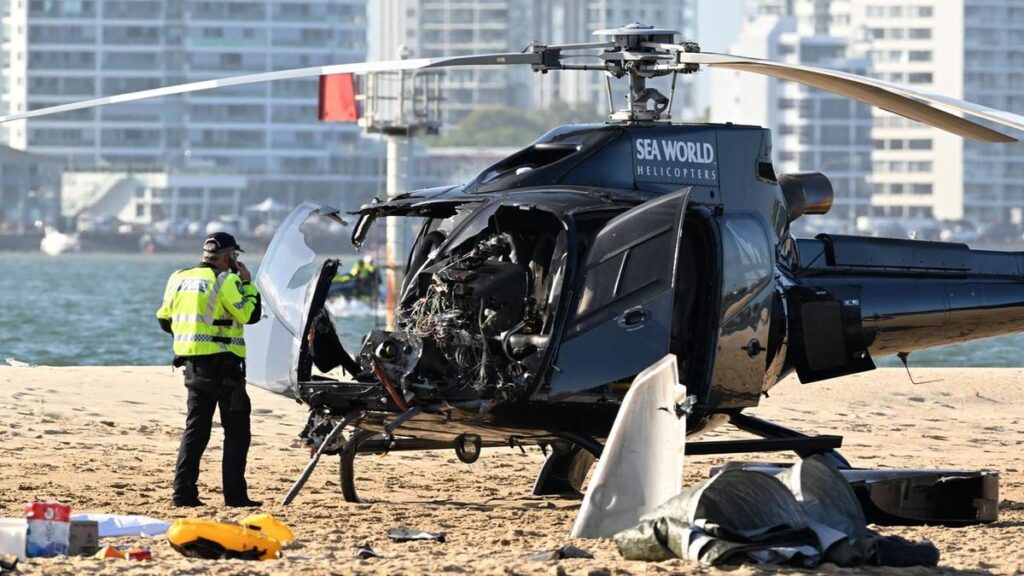Tourist Winnie De Silva booked a helicopter joy flight with her son on a whim.
It was a spur-of-the-moment decision that almost cost her life.
Moments after the Sea World chopper took off on Queensland’s Gold Coast, Ms De Silva was screaming for help from amongst the aircraft’s wreckage while explosive fuel poured onto her head.
“I was on the ground under the helicopter. There was hot machinery on my body,” she told an inquest.
“There were people telling me that help was on its way.”
Her harrowing account of the fatal helicopter collision was heard in a Brisbane courtroom as a three-week inquest began into one of Australia’s worst air disasters.
Four people died when two joy flights crashed outside Sea World on January 2, 2023, while nine were injured.
Ms De Silva had spontaneously bought tickets for a five-minute flight while she was visiting the theme park with her nine-year-old son that fateful day.
At 1.56pm as the sun shone brightly, she and her son Leon boarded a dark-coloured helicopter that took off from a helipad just outside Sea World while carrying four others.
About 25 seconds into the flight, it collided with another Sea World chopper preparing to return to the helipad.
Ms De Silva realised something was wrong when debris started flying around the spinning helicopter.
“I was holding my son’s hand and the shaking was just terrible,” she said.
“The pilot was pressing all the buttons … I was holding my son at the time, I just remember closing my eyes and requesting my son to do the same.”
The helicopter carrying Ms De Silva and her son fell 40 metres before hitting a sandbar and rolling onto its roof.
The terrified mother was pinned face down and asked two men what was falling onto the side of her head.
“They told me it was aviation fuel. I asked to pull me out and they said no as I was trapped and injured,” Ms De Silva said.
Local boaties scrambled ashore and were able to tell her that her son had survived the crash.
They also tried to wash away the jet fuel that was covering her and nearby smouldering engines.
Firefighters were able to cut into the aircraft and rescue Ms De Silva, but others were not so fortunate.
The pilot Ashley Jenkinson, 40, died in the crash, as did British newlyweds Ronald and Diane Hughes – aged 65 and 67 – and Sydney mother Vanessa Tadros, 36.
Ms Tadros’ husband Simon has attended every day of the inquest so far.
The second helicopter, piloted by Michael James, was able to perform an emergency landing on the same sandbar.
Mr James – who died from an unrelated medical condition in 2024 – and nine passengers across both aircraft were injured.
Graphic videos filmed by multiple passengers and played at the inquest showed tourists trying to get the attention of one of the pilots as the two helicopters rapidly closed in on each other.
“It’s inescapable that neither pilot saw the other pilot’s helicopter,” counsel assisting Ian Harvey said.
“How could that happen? They were two experienced pilots in modern, relatively sophisticated helicopters.”
Police officers, some off-duty, rushed to the scene, where they discovered “a terrible nightmare”.
Gold Coast Water Police supervisor Justin Dunn was there within minutes of the crash.
“It was absolute chaos,” the acting senior sergeant said.
Bystanders tried to revive one woman and gave first aid to an injured young boy.
A young ground crew member broke down into tears after testifying she blamed herself for the crash having given Mr Jenkinson the “thumbs up” to take off after she saw the skies were clear.
The two Eurocopter EC130 aircraft involved in the crash had been newly acquired by Sea World Helicopters, a company that operated independently of the theme park.
“The EC130s were pushed in before Christmas .. to use as a marketing tool,” a pilot told the Australian Transport Safety Bureau.
The bureau’s prior investigation found the EC130 offered pilots a “demonstrably more restricted” view of their take-off path.
Sea World Helicopters had doubled its number of flights for the holiday busy season, with pilots sometimes spending more than six hours a day in the air.
Nevertheless, one experienced pilot told the inquest the helicopter operator was the safest company he had worked for.
Coroner Carol Lee will resume hearing evidence on Monday as she examines 11 critical issues around the crash, including pilot training, radio communication between aircraft and any measures that could prevent a similar disaster.
https://thewest.com.au/news/disaster-and-emergency/survivors-harrowing-story-grips-chopper-crash-probe-c-20831071


